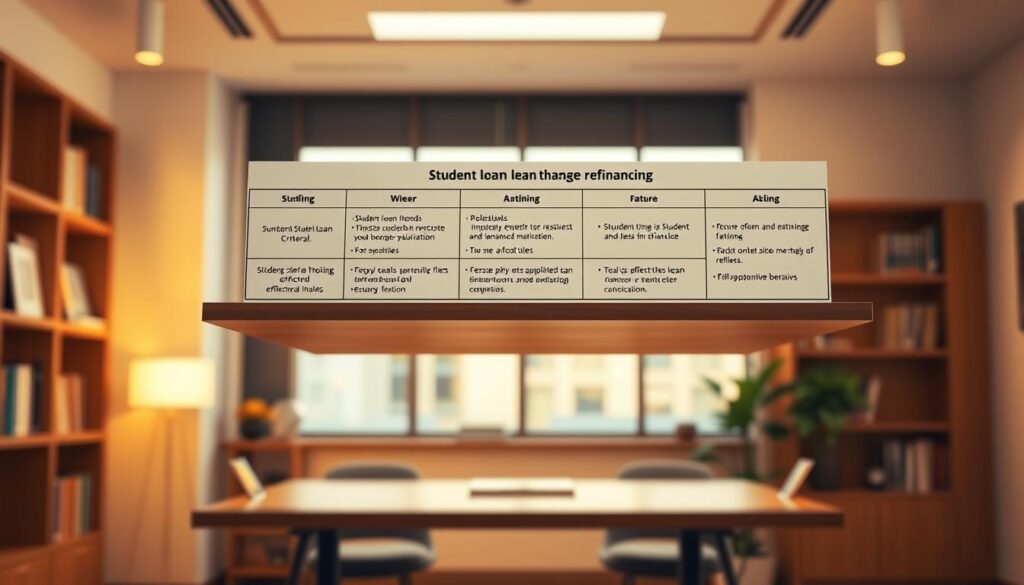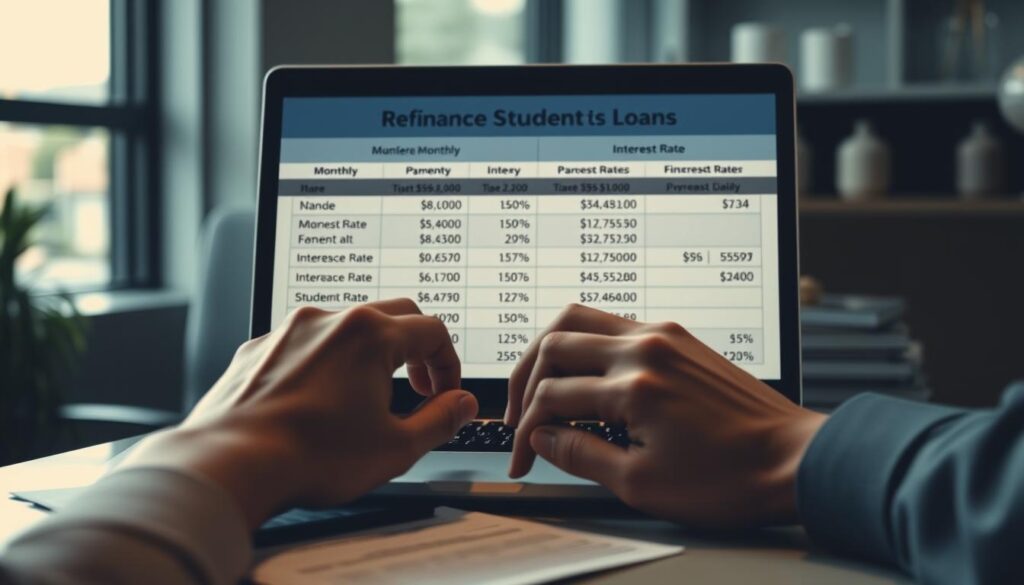Refinance Student Loans for Lower Rates and Payments
Nearly 45 million Americans owe over $1.7 trillion in education debt. This is a big financial challenge for many. Refinancing can help, by swapping high-interest loans for a new, cheaper one from a private lender.
This change can make managing money easier and save you money over time. It’s about looking at different refinancing choices. You need to think about interest rates and monthly payments to pick the right one.
Key Takeaways
- Refinancing can help simplify education debt by consolidating multiple loans into one.
- Lower interest rates can lead to significant savings over the life of the loan.
- Reduced monthly payments can improve financial stability.
- It’s essential to evaluate various refinancing options to find the best fit.
- Refinancing through a private lender can offer more flexible terms.
Understanding Student Loan Refinancing
Understanding student loan refinancing is key to making smart financial choices. It involves getting a new loan to replace existing ones. This can lower interest rates or change how you pay back the loan.
What is Student Loan Refinancing?
Student loan refinancing means getting a new loan from a private lender to pay off old loans. This new loan might have a lower interest rate or different repayment terms. The main goal is to save money by lowering interest rates.
It can also make managing your loans easier by combining them into one. This simplifies your monthly payments.
A recent report found that refinancing can save borrowers thousands of dollars. “Refinancing can be a game-changer for borrowers who are struggling with high-interest rates or unmanageable monthly payments,” says a financial expert.
How It Differs from Consolidation
Refinancing is different from consolidation. Consolidation combines loans into one through a federal program, without changing interest rates or terms. Refinancing, on the other hand, gets a new loan from a private lender, paying off old loans. This new loan has its own terms and conditions.
Refinancing can lower your interest rate, but you might lose benefits from your original loans. This includes federal loan forgiveness programs or income-driven repayment plans.
Before refinancing, consider your financial situation and credit score. A good credit score can lead to lower interest rates. But, a lower credit score might not get you the same benefits.
- Refinancing can lower your monthly payments and interest rates.
- It simplifies loan management by consolidating multiple loans into one.
- Borrowers must carefully consider the potential loss of federal loan benefits.
Benefits of Refinancing Student Loans
Refinancing student loans can greatly improve your financial situation. It can make loan terms more manageable, reduce stress, and simplify repayment.
Lower Interest Rates
One big plus of refinancing is getting lower interest rates. By refinancing, you can lock in today’s lower rates, even if your original loan had a higher rate. This can save you a lot of money over time.
For example, switching a $30,000 loan from 7% to 4% interest can save over $3,000 in interest over 10 years. This can make a big difference in the total cost of your loan.
Reduced Monthly Payments
Refinancing can also mean reduced monthly payments. This can help you manage your finances better. By getting a lower rate or extending your loan term, you can pay less each month.
For instance, refinancing to a longer term can lower your monthly payments. But, you might pay more in interest over the loan’s life. This can be a big help if you’re struggling financially.
Simplified Loan Management
Another advantage of refinancing is simplified loan management. It can combine multiple loans into one, making it easier to handle your finances. This can help you avoid missed payments and default.
For those with many loans, refinancing can make repayment easier. It simplifies your financial obligations, helping you stay on track with your payments.
When to Consider Refinancing
Knowing when to refinance your student loans is key to smart financial choices. Refinancing can help when you meet certain conditions. It might lead to lower interest rates and smaller monthly payments.
Graduating with a Stable Job
Having a stable job is important for refinancing. Lenders see borrowers with steady income as less risky. This can lead to better refinancing terms.
If you’ve just graduated and have a job in your field, it’s a good time to think about refinancing.
Changes in Credit Score
Changes in your credit score affect your refinancing options. A better credit score means lower interest rates, making refinancing more appealing. On the other hand, a lower score can make it harder to get a good deal.
It’s vital to watch your credit score and understand how it impacts your loan terms.
Interest Rate Trends
Watching interest rate trends is crucial for refinancing. If rates have dropped since you got your loan, refinancing could save you money. Keep up with market trends and be ready to refinance when rates are low.
Visit Bankrate to stay current on interest rates and trends.
Refinancing student loans isn’t for everyone. It needs careful thought about your finances, credit score, and interest rates. By understanding these, you can make a choice that fits your financial goals.
Eligibility Criteria for Refinancing
To qualify for student loan refinancing, borrowers must meet specific eligibility criteria set by lenders. These criteria check if the borrower can repay the loan.
Credit Score Requirements
A good credit score is key for refinancing student loans. Most lenders want a score of at least 650. Some might accept scores as low as 600. Borrowers with higher scores often get better interest rates.
- Excellent credit: 750+ score
- Good credit: 700-749 score
- Fair credit: 650-699 score
- Poor credit: Below 650 score
Income Considerations
Lenders also look at your income when deciding if you can refinance. They want to see a stable income and a debt-to-income ratio of 50% or less.
- Verify your income with pay stubs or tax returns.
- Ensure your debt-to-income ratio is manageable.
Existing Loan Types
The types of existing loans you have matter too. Both federal and private loans can be refinanced. But, some lenders might not refinance certain types of loans.

To see if you qualify, use a student loan refinance calculator. This tool shows your potential savings and if refinancing is a good choice for you.
Choosing the Right Lender
Refinancing student loans means finding a lender with good rates and service. With many choices, it can feel hard. But, by looking at key points, you can pick wisely.
Comparing Rates and Terms
Interest rates are key when picking a lender. Lower rates mean less money paid over time. It’s smart to compare rates from different lenders. Also, think about the loan’s terms, like how long to pay back and if payments can be flexible.
Here’s a table to help compare:
| Lender | Interest Rate | Repayment Term | Fees |
|---|---|---|---|
| Lender A | 3.5% | 5 years | $0 origination fee |
| Lender B | 3.2% | 7 years | $100 origination fee |
| Lender C | 3.8% | 10 years | $200 origination fee |
Customer Reviews and Service
Good customer service is as important as rates. Choose lenders with good reviews and quick service. This is crucial if you run into problems later.
Check out what others say. Look at the overall rating and comments. This helps you see the lender’s good and bad points.
Lender Fees and Policies
Don’t forget about fees. Some lenders charge extra for things like late payments. Knowing these fees helps you understand the loan’s true cost.
Also, check the lender’s policies on things like deferment and autopay discounts. Some offer better deals that can save you money.
By comparing rates, looking at reviews, and understanding fees, you can find a lender that fits your needs. This will help you reach your financial goals.
The Refinancing Process Explained
Understanding the refinancing process is key to making smart choices about your student loans. It can lead to lower interest rates, smaller monthly payments, and easier loan management. Here’s a simple guide to help you through it.
Application Steps
The first step is to apply to your chosen lender. You’ll need to share personal and financial details. It’s important to compare rates and terms from different lenders to get the best offer for you.
The application process has several main steps:
- Prequalification: Checking if you’re eligible without hurting your credit score.
- Application: Submitting a formal application with needed documents.
- Review: The lender checks your application and offers you a deal.
- Acceptance: You agree to the lender’s terms and conditions.
Required Documentation
To refinance your student loans, you’ll need to provide some documents. These usually include:
| Document Type | Description |
|---|---|
| Identification | Valid government-issued ID |
| Income Verification | Pay stubs, W-2 forms, or tax returns |
| Loan Statements | Current statements for the loans you’re refinancing |
Having these documents ready can make the application process smoother.
“Refinancing student loans can be a smart financial move, but it’s crucial to understand the terms and conditions of your new loan.”
Timeline for Completion
The refinancing process can take a few weeks from start to finish. Here’s a general timeline:
- Application submission: 1-3 days
- Lender review: 7-14 days
- Offer and acceptance: 1-7 days
- Loan payoff: 1-30 days after acceptance
The exact time can vary based on the lender and your situation. It’s wise to apply for refinancing early, before your next payment is due.
Potential Drawbacks of Refinancing
Refinancing student loans can have benefits, but there are also downsides. It means getting a new loan, often from a private lender. This change can affect borrowers a lot.
Loss of Federal Benefits
One big drawback is losing federal benefits. When you refinance a federal loan, it becomes a private loan. This means you won’t get federal perks anymore.
- Income-driven repayment plans
- Public Service Loan Forgiveness (PSLF)
- Deferment and forbearance options
These benefits are key for those facing financial struggles or working in public service. Without them, borrowers might default if they’re not careful.
Fees and Charges
Private lenders might charge fees for refinancing. These can include origination fees, late fees, or penalties for paying off the loan early. These costs can make the loan more expensive, even with a lower interest rate.
Some lenders offer no-fee refinancing. But, it’s important to check this and know what it means. Even without fees, the interest rate and repayment terms affect the loan’s total cost.
Impact on Loan Terms
Refinancing can change your loan terms. It might make your repayment period longer or switch your interest rate type. For example, moving from a fixed-rate to a variable-rate loan can make your monthly payments unpredictable.
Also, refinancing can lead to longer repayment periods. This might lower your monthly payments but increase the total interest paid. It’s crucial to think about how refinancing will affect your loan terms and finances.
In summary, refinancing can help with student loan debt, but it’s not without its downsides. Borrowers should weigh these factors carefully before refinancing their loans.
Frequently Asked Questions
Understanding student loan refinancing is key. We aim to clear up common questions. This will help you make smart choices about your loans.
Can I Refinance Federal Loans?
Yes, you can refinance federal loans. But, know the trade-offs. You’ll lose benefits like income-driven plans and Public Service Loan Forgiveness (PSLF).
If you want simpler payments or a lower rate, it might work. But, think it over carefully. For more info, check Citizens Bank’s FAQs on Student Loans.

How Often Can I Refinance?
You can refinance as often as you like, but it’s not always wise. Each time, you get a hard credit check, which can hurt your score. Refinance only when you get a much better rate or your finances improve a lot.
Is There a Penalty for Early Repayment?
Most lenders don’t charge for paying off loans early. But, always check your loan’s terms. This way, you avoid surprise fees.
We hope these answers help you understand refinancing better. If you’re thinking about it, carefully look at your finances and options.
Resources for Further Assistance
When it comes to refinancing your student loans, having the right tools is key. Look into various resources that can guide you through the process. This will help you make smart choices.
Comparison Websites
Use comparison websites to compare different lenders. These sites let you see rates, terms, and conditions side by side. This way, you can pick the best option for your money.
Financial Guidance
Getting financial counseling can offer personalized advice. Advisors can explain the effects of refinancing on your finances. They help you choose what’s best for your financial future.
Loan Calculators
A student loan refinance calculator is a great tool. It shows you how much you could save and what your new payments might be. With this calculator, you can see how refinancing could change your financial situation.









